Fri 6 Jun 2008
Going Wild
Posted by Shanna under South Africa
1 Comment
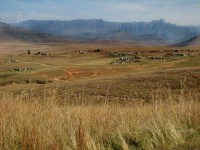
Hard-working folks in South Africa’s big cities have plenty of options to turn to when they need a break. Among the best are the Drakensberg Mountains (just a few hours from Durban) and the Wild Coast (an hour or so from East London).  Given that we’ve been on a break for, err, the last nine months or so, we’re not really in need of much R & R, but we decided to check them out anyway. (Tough life, I know…)
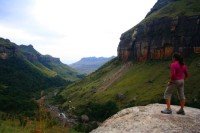
The Drakensbergs, or “Dragon Mountains,” are the second-largest in Africa.  They’re broken up into three sections, the Northern, the Central and the Southern.  We chose the first, primarily because of the Amphitheater, its most famous attraction. A five-mile-long wall of towering rock, the Amphitheater is flanked by two 10,000-foot mountains, and it’s gorgeous. We spent a day hiking over rolling hills to the rocky gorge at its base and were rewarded with stunning views and a perfect spot for a picnic.
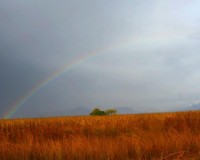
A few days later, we continued our hike, this time along the Wild Coast.  The Wild Coast stretches for 200 miles along South Africa’s southeastern coast and houses remote coves, endless sandy beaches and some of the most interesting people in the country. Great swaths of the area are inhabited by the Xhosa, whose name is pronounced with a clicking sound that we are incapable of making. (The Xhosa language itself contains an amazing 15 different kinds of clicks!) The Xhosa are some of the most superstitious people around. Many of them believe in witchcraft, and it’s not uncommon for them to burn women whom they consider to be witches.  Deceased ancestors are a very important part of Xhosa culture; they serve as go-betweens between living Xhosa and the gods.
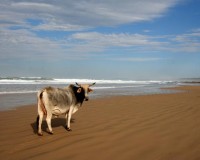
This last fact is an important part of the incredible circumstances that led to the near-demise of the Xhosa people in the 1850s. In 1856, a teenage girl named Nongqawse went down to the banks of a stream (which we walked past on our hike) to help keep birds away from her uncle’s fields. When she returned, she announced that she had met with the spirits of her dead ancestors, who told her that they had a way to help the Xhosa people recover from the hard times in which they’d recently found themselves. (At the time, their cattle were dying en masse from European diseases and their chiefs were weary from trying to defend their territory against the land-hungry Boers.)
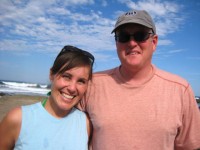
As the story went, if the Xhosa people demonstrated their belief in the spirits of their ancestors by slaughtering their cattle and refusing to cultivate their fields, the ancestors would reward them by returning from the dead, doubling the number of their cattle, multiplying their stores of grain and rendering old people young again. For many people, this was a way to salvation. Over 100,000 believers slaughtered their cattle and abandoned their fields. A significant number of nonbelievers, however, refused to. The ancestors never showed up, and a large percentage of the believers slowly starved to death. Many were sold into slavery by the British governor of the province. Today, some Xhosa (including one of our guides along our walk) believe that their ancestors refused to return because of the nonbelievers’ failure to abide by their instructions.
Many Xhosa live in an area of the Wild Coast known as the Transkei, which is an apartheid-era “homeland” to which black people were forced to relocate during the sad decades leading up to the 1991 liberation. Nelson Mandela, a Xhosa himself, was born and raised here.
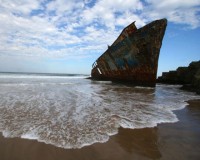
Today, both the Transkei and the Wild Coast’s beaches are largely uninhabited. We hiked along the beach for almost three days and encountered very few people, other than our guide and the staff who ran the guesthouses in which we stayed every night. What we did see were dolphins gliding through the waves (it seems they like to “surf”), cows using the shoreline as a salt lick, a shipwreck with a funny story behind it (watch the video for more details) and even, lucky for us, a whale. There are few things in the world that I like more than walking on the beach, and I’m happy to say that, after days of doing nothing but, I may have had my fill–at least for a little while…
Drakensberg:
[embedplusvideo height=”350″ width=”450″ editlink=”http://bit.ly/1sL4hUX” standard=”http://www.youtube.com/v/NCaghiAqi34?fs=1″ vars=”ytid=NCaghiAqi34&width=450&height=350&start=&stop=&rs=w&hd=0&autoplay=0&react=1&chapters=¬es=” id=”ep8330″ /]
Wild Coast:
[embedplusvideo height=”350″ width=”450″ editlink=”http://bit.ly/1r6jdk1″ standard=”http://www.youtube.com/v/d7bq9lFZ8Ko?fs=1″ vars=”ytid=d7bq9lFZ8Ko&width=450&height=350&start=&stop=&rs=w&hd=0&autoplay=0&react=1&chapters=¬es=” id=”ep8759″ /]
Google Video
Wow. That’s an interesting story. A lot of cultures blame their persecution by the white man as a failure to abide by the rules of their ancestors. In fact, many cultures blame any ruin (famine, disease, etc) on such a thing.
Good story. Thanks for sharing…I’d never even heard of the tribe before hand.